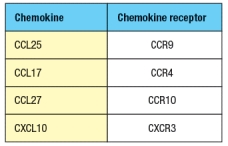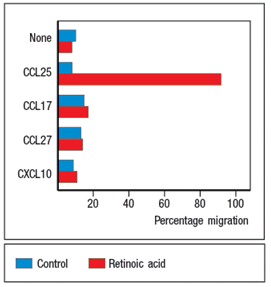Purified CD4 T cells were stimulated in vitro with anti-CD3 plus anti-CD28 antibodies to activate them, and cultured for two days in the presence or absence of all-trans retinoic acid (RA). The T cells were then stained with antibodies to either a 4: 7 integrin or for E/P-selectin ligand expression and analyzed by flow cytometry. The results are shown in the upper graph in Figure. In a second assay, the cells were tested for their ability to migrate in response to a panel of chemokines, and the percentages of migrated cells were measured, as shown in the lower graph. Note that these chemokines are ligands for the receptors as indicated in Figure. In the absence of infection or inflammation, where are naive T cells encountering RA, and based on these data, what effect will this have on their subsequent behavior? 


Correct Answer:
Verified
Q1: NOD proteins are intracellular sensors of infections
Q2: Salmonella typhimurium is the causative agent of
Q4: Analysis of human milk from lactating mothers
Q5: Mice lacking the poly Ig receptor (pIgR)
Q6: Infection of mice with the bacterial pathogen,
Q7: Oral inoculation with rotavirus, an intestinal pathogen,
Q8: The TACI receptor on B cells, which
Q9: Patients receiving hematopoietic stem cell transplants
Q10: The mucosal immune system provides protection for
Q11: Vibrio cholerae causes an acute diarrheal illness
Unlock this Answer For Free Now!
View this answer and more for free by performing one of the following actions

Scan the QR code to install the App and get 2 free unlocks

Unlock quizzes for free by uploading documents